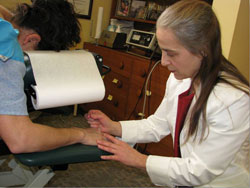Reproductive Acupuncture
Your reproductive health can be vitalized with Reproductive Acupuncture! Dr. Mudrak, a member of the American Society of Reproductive Medicine (ASRM), is thoroughly abreast of the most current research supporting acupunctures influence on promoting pregnancy and reproductive health and the clinical acupuncture techniques necessary to achieve healthy reproductive function and pregnancy. Your first step in this reproductive journey will begin with

Dr. Mudrak conducting a Traditional Chinese Medical (TCM) consultation along with tongue and pulse diagnosis to derive a TCM diagnosis.
Your treatment protocols at the Reproductive Acupuncture Center will be determined utilizing:
- The most up-to-date reproductive acupuncture research;
- Ancient and time-proven fertility treatments from the vast body of knowledge of gynecology in Traditional Chinese Medicine; and
- Dr. Mudrak's clinical experience and expertise in reproductive acupuncture.
Dr. Mudrak also utilizes individually customized nutritional plans with very targeted nutriceutical therapy, TCM herbal therapy and chiropractic care as needed to promote conception and maintain healthy pregnancies.
Current clinical research and randomized studies show how reproductive acupuncture can vitalize your reproductive health to achieve a healthy pregnancy. Researchers from Weill Cornell Medical Center conducted a literature review published in Fertility and Sterility [1] (the premier medical journal devoted to fertility and reproductive medicine published by the ASRM) examining the scientific basis of mechanisms by which acupuncture:
- Increases blood flow to the uterus, thus improving the conditions for an ovum to implant on the uterine wall;
- Normalizes the endocrine system and production of hormones that regulate ovulation, especially in women with polycystic ovarian syndrome (PCOS);
- Positively affects the hypothalamic-pituitary-ovarian axis leading to effective communication and function of the reproductive organs;
- Regulates menstrual cycle; and
- Inhibits the sympathetic nervous system, allowing the parasympathetic release of opiates and beta-endorphins, which promote the sense of emotional well being by reducing anxiety and emotional distress and increasing relaxation.
Acupuncture & Pregnancy
A landmark study published in Fertility and Sterility [2] highlights the positive impact of acupuncture on pregnancy rates of infertile women treated with in vitro fertilization (IVF). The women who received acupuncture and IVF had a sixteen percent (60%) increase in rate of pregnancy compared to the group treated with IVF only. Acupuncture substantially increases the pregnancy rate when used in conjunction with IVF as well as other assisted reproductive techniques (ART). (Please see the Research Science section of this website for more information.)
References
[1] Chang M.D., Raymond, “Role of Acupuncture in the Treatment of Female Infertility”, Fertility and Sterility, vol. 78, no. 6, 2002, pp. 1149-1153.
[2] Paulus M.D., Wolfgang E., et. al., “Influence of Acupuncture on the Pregnancy Rate in Patients Who Undergo Assisted Reproductive Therapy”, Fertility and Sterility, vol.77, no.4, April, 2002.
Medical Diagnosis and Surgery
Dr. Mudrak also recognizes the areas in which medical reproductive approaches are superior or even the only options for diagnosing and treating infertility conditions caused by structural obstacles such as fibroids, endometriosis, damaged fallopian tubes, anatomical defects and/or anomalies, Asherman's syndrome, etc. OB/GYNs and/or reproductive specialists are successful in diagnosing and treating with endometrial biopsies, hysterosalpingograms, laparoscopies, sonohysterograpghy, laparatomy, and hysteroscopy, etc., to eliminate these problems with appropriate corresponding surgical procedures. Without the availability of reproductive medical diagnosis and surgical treatment these structural obstacles to fertility would be a permanent condition. Acupuncture cannot correct these obstacles, but it can be utilized to promote healing and speed recovery after surgery and regulate the underlying body systems to prevent a return of the condition in the remaining reproductive years of the woman.

